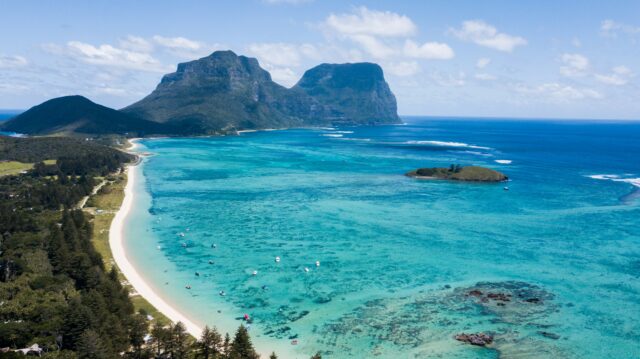Introduction
Lord Howe Island, located 372 miles off the east coast of mainland Australia, is a pristine paradise that seems ripe for over tourism. With its lush mountaintops, white-sand beaches, and clear blue waters teeming with vibrant marine life, the island offers an idyllic escape. Yet, the island remains unspoiled and uncrowded, with a cap of 400 tourists at a time. This limit is key to preserving the island’s unique environment and ensuring a sustainable tourist experience.
The Secret to Lord Howe Island’s Unspoiled Landscape
Lisa Makiiti, a sixth-generation islander and owner of the Bowker Beach House, emphasizes the value of limiting tourism to maintain the island’s natural beauty. “It’s what is not here that provides that experience – that is why it’s so unique,” she says. This approach contrasts sharply with other tourist destinations that often aim for bigger and better attractions.
For over 40 years, the island has limited its tourist numbers by capping the number of available beds. This strategy protects the island’s unique endemic species, contributing to its recognition as a UNESCO World Heritage site in 1982. Although the number of tourists allowed is somewhat arbitrary, maintaining this cap has minimized environmental impacts and created a unique visitor experience where there’s roughly one tourist per local resident.

Challenges of Visiting Lord Howe Island
Due to the strict cap on visitors, securing a spot on the island can be challenging. Bookings at Bowker Beach House, for instance, extend well into 2026. Airfares for a return trip to Sydney can exceed $666, and peak season accommodation ranges from $200 to over $3,000 per night. These challenges underscore the island’s commitment to sustainable tourism.
Commitment to Preservation
Dean Hiscox, who runs Lord Howe Environmental Tours, highlights the community’s united effort to prioritize nature. Over 85% of the island remains covered in native forest, with 70% designated as a Permanent Park Preserve, prohibiting any development. The residential area is limited to 15%, ensuring minimal human impact.
The local community, many of whom are descended from the original settlers, strongly supports these preservation efforts. “Those families that have been here for generations recognize how special their lifestyle is here,” says Ian Hutton, a naturalist and photographer who has lived on the island since 1980. This generational commitment to protecting the island is a cornerstone of its sustainability.
Unique Flora and Fauna
Life on Lord Howe Island is akin to living in a David Attenborough documentary, with its dense rainforests and unique wildlife. The island is home to plants and animals found nowhere else, including the rare cloud forest atop Mount Gower and the famous Kentia Palm.
The Providence Petrel, a seabird that breeds mainly on Lord Howe, is known for its friendly nature, often swooping down to visitors who can even pick them up. The proximity to nature is a major draw, with beaches, hiking trails, and the world’s southernmost barrier reef teeming with marine life just minutes away from accommodation.

Sustainable Tourism Practices
Tour guides on the island emphasize the importance of sustainability to visitors, who are generally already tuned into this philosophy. Many tourists participate in local conservation efforts, such as paid weed eradication programs and citizen science campaigns.
Strict biosecurity measures are in place to protect the island from invasive species. All imports and visitors are checked, including by sniffer dogs trained to detect pests like rats and frogs. Hikers must scrub their boots to prevent the spread of fungus, highlighting the island’s intense conservation efforts.
Overcoming Challenges and Preserving Lifestyle
Historically, the island was isolated, accessible only by seaplane until an airstrip was built in the 1970s. This isolation has bred a unique, self-sufficient lifestyle among residents. There is no secondary school, so children must attend boarding schools or study remotely. Imports, including food, arrive fortnightly, making the cost of living high. However, residents offset costs by farming and bartering goods.
Sustainability is deeply ingrained in the community’s lifestyle. Around 80% of the island’s electricity comes from a community solar grid, and residents are meticulous about sorting waste and recycling. These practices ensure that the island’s natural environment remains pristine.
The Impact of Climate Change
Despite the community’s efforts, climate change poses a significant threat to Lord Howe Island. Rising temperatures and severe weather events have caused coral bleaching and dieback in the cloud forest. The island’s future depends heavily on global efforts to combat climate change.
Conclusion
Lord Howe Island’s success in preserving its natural beauty while providing a unique tourist experience is a model for sustainable tourism. By capping visitor numbers, enforcing strict biosecurity measures, and fostering a deep respect for the environment, the island maintains its pristine condition. As climate change threatens its delicate ecosystem, the island’s practices offer valuable lessons in sustainability and conservation.
Lord Howe Island demonstrates that less is more. Its commitment to preserving the environment and maintaining a low-impact tourist industry ensures that this paradise remains unspoiled for future generations. The island’s unique approach to tourism not only protects its natural wonders but also offers visitors an unparalleled experience of tranquility and natural beauty.











